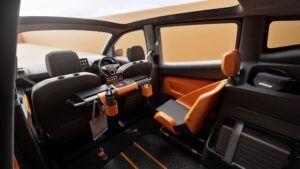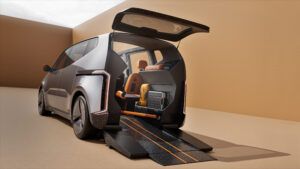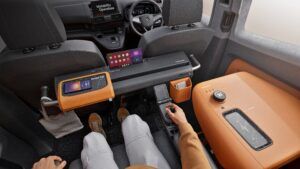An modern and daring next-generation EV idea is pushing the boundaries of design and engineering within the wheelchair accessible car (WAVs) area. eVITA has been devised by CALLUM, the Warwick-based design and engineering enterprise co-founded by automotive design legend Ian Callum, whose roll name of automotive creativity consists of the Aston Martin DB7 and the Jaguar XJ and the I-pace, Jaguar’s first all-electric automotive.
“At this time, electrical automobiles will not be providing the performance and suppleness required by WAV customers,” says Ian Callum, design director at CALLUM. “OEMs, their designers and engineers should plan forward and embrace inclusive design ideas to make sure that WAV customers and disabled persons are not forgotten within the transition to EVs. With eVITA, kind and performance have been developed in parallel, leading to a well-considered, user-friendly EV that’s each sensible and trendy.”
 Designing an eWAV that’s each aesthetically pleasing and practical for its customers has its challenges. At the moment, typical EV structure, with the battery in flooring, restricts area and headroom within the cabin. With out options developed with inclusivity and accessibility in thoughts, clients in wheelchairs normally should go for bigger automobiles than they want when switching to electrical. However the eWAV’s putting exterior silhouette, with its modern roofline accommodating entry necessities, gives acceptable headroom for wheelchair customers, who enter the car through a rear cut up tailgate. With a wheelbase of two,980mm, eVITA is 4,520mm lengthy, 1,908mm huge and 1,800mm excessive – dimensions which give eVITA a much more compact footprint than obtainable at present.
Designing an eWAV that’s each aesthetically pleasing and practical for its customers has its challenges. At the moment, typical EV structure, with the battery in flooring, restricts area and headroom within the cabin. With out options developed with inclusivity and accessibility in thoughts, clients in wheelchairs normally should go for bigger automobiles than they want when switching to electrical. However the eWAV’s putting exterior silhouette, with its modern roofline accommodating entry necessities, gives acceptable headroom for wheelchair customers, who enter the car through a rear cut up tailgate. With a wheelbase of two,980mm, eVITA is 4,520mm lengthy, 1,908mm huge and 1,800mm excessive – dimensions which give eVITA a much more compact footprint than obtainable at present.
Important to the design of eVITA is the positioning of the battery. Led by engineering director Adam Donfrancesco, the CALLUM engineering crew has repackaged the EV battery, rearranging the inner elements to scale back its general peak. With the reengineered battery pack positioned below the ground behind the primary row of seats, the design ensures that the ground between the car tailgate and entrance row is totally flat. The car’s 50kWh battery gives an anticipated vary of round 200 miles.
“The elemental engineering problem of an eWAV is a battery bundle one,” says Donfrancesco. “We repackaged the modules within the battery, however the adjustments aren’t actually recognised by the automotive, as a result of from a system perspective, the efficiency is similar. There was fairly a bit of labor to make it possible for the coolant circulation is similar, that the resistance is similar and, clearly, that the structural efficiency is there in equivalency. A variety of profiling of current batteries to know them after which making certain that we’re acheiving that profile once we manufacture the idea battery.”
 This packaging design permits for a trip peak of 160mm, just like that of a hatchback. This contributes to simpler entry and elevated headroom. It additionally implies that the wheelchair consumer has an improved, decrease seating place within the cabin. Having wheelchair customers at the same peak to different car occupants helps them to really feel extra related to different passengers and in addition improves visibility (with a better seating place, visibility could be restricted by the roofline). Sitting decrease, in a glasshouse of over 35,000cm2 with a cutaway panoramic roof, ensures optimum visibility for all car occupants.
This packaging design permits for a trip peak of 160mm, just like that of a hatchback. This contributes to simpler entry and elevated headroom. It additionally implies that the wheelchair consumer has an improved, decrease seating place within the cabin. Having wheelchair customers at the same peak to different car occupants helps them to really feel extra related to different passengers and in addition improves visibility (with a better seating place, visibility could be restricted by the roofline). Sitting decrease, in a glasshouse of over 35,000cm2 with a cutaway panoramic roof, ensures optimum visibility for all car occupants.
Donfrancesco and his crew are additionally very happy with their modern work on their automotive’s cut up tailgate, an electrical door opening system with an higher part that acts as an extension to the roof, maintaining customers dry when getting into and exiting in moist climate. A large, low angle ramp routinely extends from inside, with a winch aiding wheelchair customers’ entry into the car cabin. Usually, a ramp in a WAV would hinge on the rear of the car, however within the eVITA, says Donfrancesco, “there’s a hinge level within the car flooring, so the ground goes down, then the tailgate drops down after which falls out. The ramp is definitely contained inside the tailgate. It’s a singular function in automobiles like this.”
eVITA additionally options two charging ports – one on the nearside rear and a decrease front-mounted choice – a extremely damped rear suspension for predictable dealing with, energy-efficient LED puddle lights that visually undertaking onto the bottom the important area required for the prolonged ramp on the rear of the car, alerting different motorists to maintain the area clear.
Idea vehicles are usually futuristic flights of fancy, designed to wow motorshow attendees and hoover up likes on Instagram, with little hope of ever making it to manufacturing. eVITA is totally different, swapping the if-only-one-day designer’s dream for the fact of what’s potential with an eWAV as we speak, and to begin essential conversations with OEMs and throughout the whole automotive trade about inclusive design being entrance and foremost within the car improvement course of in order that nobody is left behind within the transition to EVs.
“The converters within the trade in the meanwhile do a incredible job,” Donfrancesco factors out, “however what they’re given to work with is a production-line-based car, which isn’t designed in any strategy to have that conversion. And so they handle to ship the merchandise they do in the meanwhile, that are nice. But when OEMs take into consideration issues from the bottom up, so for those who’re in a position to bake in a few of these options, early on within the car’s improvement, you may get a a lot better finish consequence, That is precisely why we’re doing eVITA: to develop authentic and distinctive options, but in addition to get some traction and deal with this concern with the OEMs.”
 The evolution of eVITA
The evolution of eVITA
This idea is born of a co-operation between CALLUM and Motability Operations, the business organisation that delivers mobility options to over 760,000 disabled folks throughout the UK. It at present has in its fleet of vehicles, wheelchair accessible automobiles (WAVs), powered wheelchairs or scooters over 34,000 battery electrical car clients and greater than 83,000 clients driving hybrids. In current proof to the Home of Lords Atmosphere and Local weather Change Choose Committee Inquiry on EVs, Motability mentioned virtually half of its customers are dedicated to their subsequent car being electrical.
Yearly about 4,000 folks apply for WAVs by way of the scheme. At the moment, converters adapt current automobiles, however purpose-built, first-principle wheelchair entry automobiles present a a lot better expertise for the consumer, which is why Motability Operations approached CALLUM with the temporary to create a bespoke eWAV.
“Collaboration is vital to creating the EV transition successful for wheelchair customers,” says Motability Operations CEO, Andrew Miller. “We want our companions, producers and coverage makers to imagine in higher and to work alongside us to take motion. eVITA reveals what could be finished.”
The idea has already modified hearts and minds. “We’re in talks with all kinds of individuals, as are Motability Operations,” says eVITA engineering lead Adam Donfrancesco of CALLUM. “It’s actually making waves and acquired the response all of us needed. It’s acquired the dialog began proper.”


